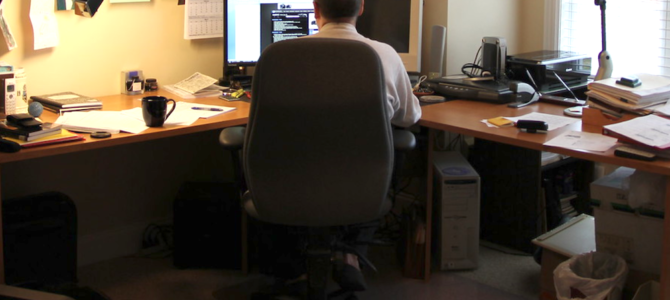
The coronavirus outbreak is disrupting nearly every facet of American life. Many of these changes are temporary and will be forgotten as soon as the Wuhan coronavirus pandemic subsides — but not all.
Changes rippling through daily life right now will present, for the first time, an alternative to the normal way of doing things, and some will be improvements. One bright spot in this medical and economic catastrophe is that millions of workers will find that working from home is not only possible, but preferable. The effects of that will be considerable.
All You Need Is the Internet
Lots of people work from home already, including many of the authors whose work you read on this website. Others’ jobs cannot be done from home, including many people who are still working right now: doctors, nurses, police officers, firefighters, and more. In between those two groups, however, are millions of office workers whose jobs can take place anywhere there is an internet connection. The only thing stopping them from working remotely until now was their bosses’ belief that working in an office is better for the bottom line.
That belief is now being put to the test. Forced to let their employees work from home, managers are compelled to test the theory in real time. It is not a perfect test. Some employees’ work will suffer because their children are stuck in the house with them. Even so, for many, it will prove what they have long suspected: Working at home is not only possible but is every bit as productive as trudging into an office each day.
Much of what prevented the work-from-home revolution from taking hold earlier was the belief that productivity would be too difficult for managers to monitor. This is really just a preference for the old way of doing things. A boss who judges employees by “face time” and other appearances of productivity is missing out on actual measures of production, whether in person or miles away. Anyone who has worked in an office knows there are ways of goofing off that bosses miss, and we all know some co-worker who does far less work than his manager believes he does.
Smarter managers already lean more on objective measures of productivity, looking at what workers produce rather than how often they see their faces. Bosses can monitor how many assignments are completed and how quickly they are done from down the hall or across the country. The size of the stack of files on your desk really doesn’t matter anymore.
Think of the Savings
Working from home produces a variety of savings. Right away, workers get back all the time they spend commuting. For many people, that’s a significant time savings. The average American commutes 27 minutes to work each way, but even that average doesn’t tell the whole story. In many large urban areas, the average commute is more than 40 minutes each way, and we all know of people whose ride to work is far longer than that.
What would you do if you had that time back? You could sleep a bit later, have more leisure time, or spend more time with the kids. You could even do more work if you were so inclined. Even for those people who can’t work at home, the absence of other commuters from the road will make their ride to work quicker and less frustrating.
There is also money to be saved. Every gallon of gas or train fare you don’t have to buy puts money in your pocket. Working at home becomes an instant salary raise. Eating lunch at home also saves money. Office workers don’t have to go out for lunch, and many don’t, but being just a few feet from your own kitchen makes the choice easier. Overall, workers can save a great deal of time and money by making their home their workplace.
Revive Small Towns
All of that can happen right away when people switch to home offices, but a permanent shift would introduce more widespread benefits. The past few decades have seen an acceleration and centralization of the old urbanization trend. People have been moving from the country to the cities since the Industrial Revolution (longer in some places), but in our lifetimes, the shift has gotten even more profound. Small cities and larger towns are now suffering the same fate as rural areas, with the great coastal metropolises draining wealth and talent from the rest of the country.
Remote workplaces can begin to reverse this trend. Everyone knows the price of housing in New York and San Francisco has skyrocketed for years, with no end in sight. But America as a whole does not suffer from a housing shortage. Houses and apartments cost more where the demand is highest: where the jobs are. Efforts to build more housing in these areas fail, because of NIMBYs, overregulation, or the high cost of building there.
If the jobs are no longer tied to big cities, though, if they can exist anywhere with an internet connection, everything changes. Affordable houses in smaller cities and towns across America now become a feasible option for people whose careers once tied them to more expensive venues. Moreover, the salaries from those big-city jobs go a lot further outside them, even beyond the difference in housing costs. All of a sudden, the rest of the country would have a comparative advantage.
There’s more to be gained here than money. Every time members of a community must forsake their hometowns to advance their careers, they lose something in the experience. The people they leave behind lose out, too. Much of people’s search for meaning in life is tied to the community from which they came. When long-standing relationships shatter, they are not easily recreated. What’s occurred is more than a brain drain or a money drain; it is a community drain.
Some people will still live in the crowded, expensive cities, either because they like it or because they truly must do their jobs in person. But for millions of Americans, remote workplaces offer a range of choices none of us have known before. Most of the effects of the coronavirus will be bad, but by increasing the freedom to work from home, we can do some good for workers and for struggling communities across the country.









